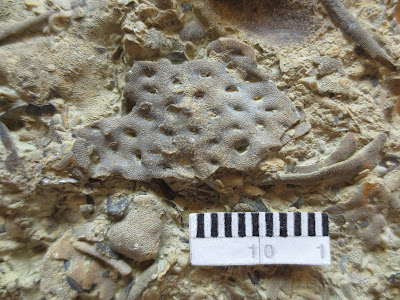Restoring an ankylosaur is not the easiest thing in the world, because usually they died without bothering to keep their armor together. This makes it all the more disheartening when details are missed when working from the few well-preserved examples. For example, with
Borealopelta, even though photos abound and there are two publications with many illustrations (both of which can be
freely accessed), many restorations don't accurately reproduce the armor pattern. For reference:
The pattern of osteoderms over the torso is composed of transverse bands of distinct single rows of osteoderms. The bands alternate between wider, more prominent rows of larger, modestly keeled osteoderms and narrower rows of much smaller, unkeeled, roughly equant osteoderms. Significantly, the long axes of the larger scutes are oriented transversely to the body (i.e., they appear wider than long), not parasagittally, as they are frequently restored (the
CollectA Borealopelta, which gets other details right, fudges on this, as well as the next thing). This pattern is not unlike the articulated armor known for
Nodosaurus.
The pattern of osteoderms over the hips is not an extension of the torso armor, but is composed of generally polygonal pieces in a more tightly fitting mosaic, with an irregular distribution of filler osteoderms. This is not unlike the pattern seen in the pelvic armor of
Stegopelta.
 |
| It's such a lovely specimen, let's look at it some more! Figure 1 from Brown (2017). CC-BY-4.0. |
It should also be noted that placing an osteoderm pattern found on one ankylosaur onto another, more poorly known ankylosaur is a crapshoot. Known articulated ankylosaur torso armor varies widely:
Kunbarrasaurus has a scattering of very small osteoderms between the shoulders and hips, and several relatively large pointed osteoderms situated at the hip-tail transition.
Borealopelta has the pattern described above, which also incorporates large spikes and large keeled osteoderms in the neck and shoulder region.
Edmontonia has three bands of large keeled scutes on the neck and shoulders, a lateral fringe of spiky osteoderms to just past the shoulders, and then small osteoderms in a groundmass of minute pieces. (Restorations that show
Edmontonia or "
Palaeoscincus" often mix the correct anterior armor with an imaginary post-shoulder pattern of a brickwork of large scutes, derived ancestrally from Barnum Brown's
hypothetical skeletal restoration of Ankylosaurus as a sort of cobblestone
Stegosaurus with the short tail of a ceratopsid.)
 |
| No cobblestones on the back of Edmontonia. |
Sauropelta is something like a lazy
Borealopelta, with vague transverse bands of larger circular or ovate osteoderms separated from each other by abundant groundmass osteoderms.
 |
| Round, slightly peaked, and loosely aligned osteoderms on Sauropelta. |
What we have of
Pinacosaurus indicates bands of large strongly keeled scutes on the sides and tail.
 |
| Pinacosaurus is about as close to the classic cobblestone pattern as is known at this time. |
Scolosaurus, represented by one of the earliest known well-articulated armor patterns, has had an outsized influence on ankylosaur restorations, along with
Edmontonia/"
Palaeoscincus" and the cobblestone
Ankylosaurus. It is known for a relatively small number of large conical or keeled scutes set in broad transverse bands of smaller osteoderms.
Photos of Zuul indicate something similar but with even larger osteoderms. The boundaries of the bands are often depicted as stark and well-defined, with the animal having a sort of jointed carapace, but photos show more subtle boundaries. In hindsight,
Scolosaurus can be seen as the prototype for "banded
Hylaeosaurus" restorations made popular by the "Illustrated Encyclopedia of Dinosaurs". It's not clear why
Scolosaurus should have been chosen as the model given that the
known armor of Hylaeosaurus consists of large elongate spiky osteoderms and flattened plates from the neck and shoulders, quite unlike that of
Scolosaurus.
 |
| Click to zoom and see for yourself: the bands are not starkly delimited. Photo by "the paleobear", found at Wikimedia Commons. CC-BY-2.0. |
A casual look at ankylosaur restorations will show that exaggerated armadillo-like bands derived from
Scolosaurus are one of the more popular patterns chosen for restoring ankylosaurs. This pattern at least has the benefit of being based on an actual specimen, unlike the cobblestone or "brick house" of adjoining large osteoderms, or the "undifferentiated sea of small pointed bits".
References
Brown, C. M. 2017.
An exceptionally preserved armored dinosaur reveals the morphology and allometry of osteoderms and their horny epidermal coverings. PeerJ 5:e4066. doi:
10.7717/peerj.4066.


















